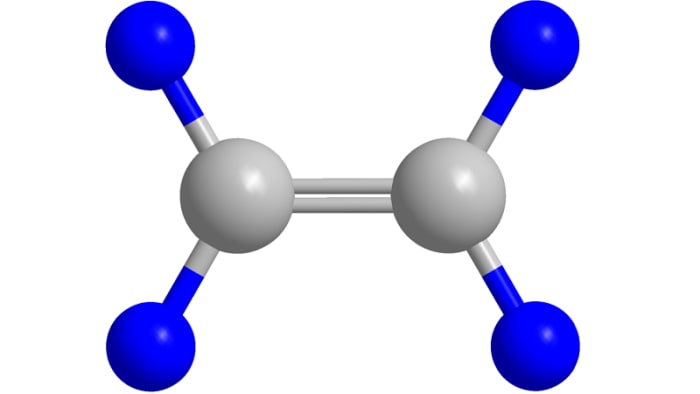
Method of Preparation of Alkenes

Alkenes are the hydrocarbons which contain a double bond and the number of hydrogen atoms is twice the number of carbon atoms. The structure of alkene is between any two adjacent or adjoining carbon atoms and they form a homologous series. Therefore, the general formula for an alkene is called CnH2n. The simplest alkene consists of a single double bond in its structure ethene, where eth means two and ene means a double bond and so it is expressed by the formula C2H4. In industry, Alkenes have many important uses and they also play an important role in our everyday lives.
Table of Contents
Preparation of Alkenes
Zaitsev’s Rule
Carbocation rearrangement
Inductive effect
Preparation of Alkenes
Preparation of Alkenes From Alkynes
We can use Alkynes in order to prepare alkenes. The reduction of alkynes leads to the conversion of Alkyne to alkene conversion. We do this with the help of hydrogen in the presence of palladised charcoal, palladised means in presence of palladium with deactivated charcoal. Activated charcoal is deactivated using quinoline or sulfur compounds. Palladised charcoal that has been partially deactivated is called Lindlar's catalyst. The alkenes which we obtain from the above reaction are cis geometry in structure. Through reduction by sodium in liquid ammonia, alkynes can be converted into trans alkenes.
Preparation of Alkenes From Alkyl Halides
When we heat alkyl halides with the help of alcoholic potash then we obtain alkenes. A potassium hydroxide solution is dissolved in alcohol to yield alcoholic potash. The rate of the reaction depends on the nature of the halogen group and the type of alkyl group attached to the halogen group. Dehydrohalogenation removes a single molecule of halogen acid.
Preparation of Alkenes From Vicinal Dihalides
Vicinal dihalides are dihalides formed when two adjacent carbon atoms are attached to two halogens. Alkenes are formed when such dihalides react with zinc metal and lose their halogen molecules. This type of reaction is called dehalogenation, as it results in alkenes being formed from Vicinal dihalides.
Dehydration of Alcohol
A water molecule is eliminated from the reactions between alcohol and concentrated sulphuric acid, which results in the formation of alkenes. As water molecules are removed in this reaction, it is known as acidic dehydration of alcohol, and concentrated sulphuric acid is used to dehydrate alcohol.
Dissociation of the Oxonium Ion
The oxonium ion dissociates into a carbocation and a positively charged carbon atom that is an unstable intermediate.
Deprotonation of the Carbocation
In the overlap region, the positively charged end carbon of the carbocation attracts electrons that bond it to the adjacent carbon. This electron movement makes the atom slightly positive, which draws electrons in the overlap regions of all other atoms that are attached to it. Due to this, hydrogen on the α carbon becomes very slightly acidic, allowing it to be removed as a proton during an acid-base reaction.
Zaitsev’s Rule
A double bond may be formed by the loss of hydrogen atoms from two different carbons on a carbocation during an alcohol dehydration reaction. An observation called the Zaitsev rule states that the major product is always the more highly substituted alkene with the greatest number of substituents on the carbon atoms of the double bond. The following products are formed during the dehydration reaction of 2‐butanol.
According to the Zaitsev rule, 2-butene will be the major product. We notice that each carbon atom which is involved in forming the double bond of 2‐butene has one methyl group which is attached to it. In the case of 1‐butene, one carbon atom of the double bond has one substituent (the ethyl group), while the other carbon atom has none.
Carbocation rearrangement
It is possible for the carbocation to rearrange itself during alcohol dehydration to form more stable arrangements. For instance, dehydration of 2-methyl-3-pentanol produces three alkenes. The reaction mechanism indicates that the additional compound is created by rearrangement of a carbocation intermediate during the reaction.
When we rearrange the intermediate carbocation then 2‐methyl‐1‐pentene molecule is formed
When the hydride ion (H: ‐) moves, it results in the formation of a more stable carbocation. Carbon atoms are classified as primary, secondary, and tertiary carbocations. A primary carbocation has one alkyl group attached to it; a secondary carbocation has two alkyl groups attached; and a tertiary carbocation has three alkyl groups attached.
Inductive Effect
It is theoretically possible for alkyl groups to “push” electrons from themselves. This phenomenon is known as the inductive effect. Increasing the number of alkyl groups pushing electrons toward a positively charged carbon atom will increase the stability of the intermediate carbocation. It is due to the delocalization of charge density that this increase in stability occurs. Charges create stresses on atoms. As the stress spreads through a molecule, the charge density on each atom becomes smaller, reducing the stress. This makes the ions more stable as a result. Thus, tertiary carbocations, which have three alkyl groups on which to delocalize the positive charge, are more stable than secondary carbocations, which have only two alkyl groups on which to delocalize the positive charge. As a result, secondary carbocations are more stable than primary carbocations.
Electrons are not “pushed” away from alkyl groups, but rather removed from them by alkyl groups. A positive charge changes an atom’s electronegativity when it becomes an ion. The electronegativity of two carbon atoms determines in part where the overlap region is located relative to each carbon atom in the original sigma bond between two carbon atoms. The overlap region shifts closer to the positively charged, electronegative carbon atom when the electronegativity of one of the carbon atoms increases as a result of ion formation. By rearranging electron density, the neighboring carbon receives a partial positive charge. The amount of charge gained by the second carbon atom is the same as the amount lost by the fully charged carbon atom. As a result, the charge is delocalized over two carbons.
Appreciate the creator